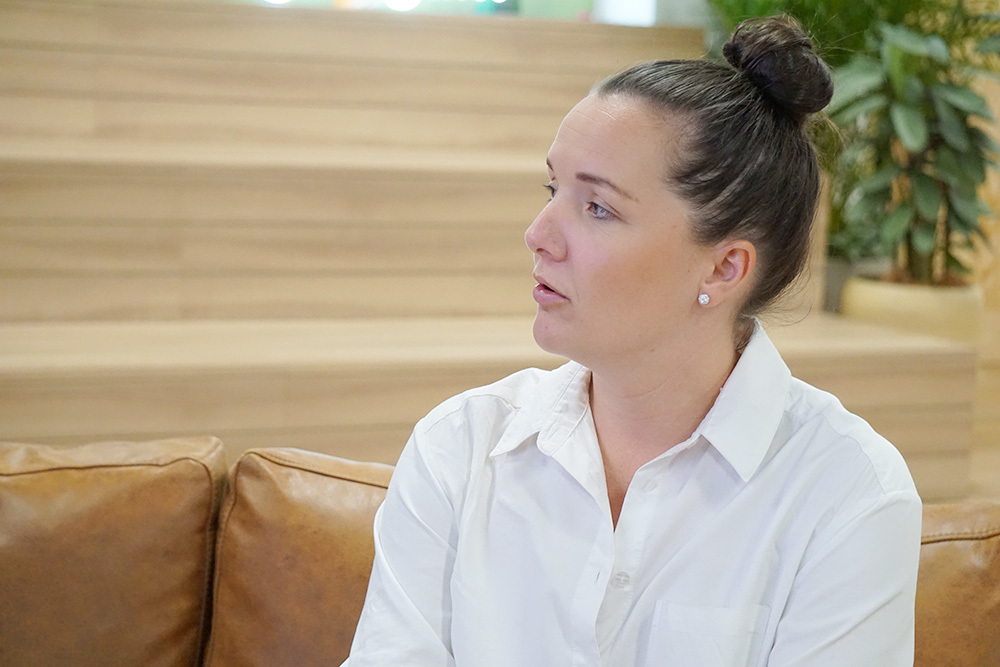How to Leverage Attention Metrics: Insights from GumGum Japan, Possessing Unique Data for the Japanese Market

Jake Seri
Playground XYZ

Sorel Osborne
Playground XYZ

Kenzo Serby
GumGum Japan

Attention measurement is suddenly gaining attention as a method for measuring the effectiveness of branding ads, a challenge that has long troubled marketers. How exactly can this new methodology, still relatively unfamiliar in the Japanese market, be utilized? We spoke with representatives from GumGum and its subsidiary Playground XYZ, who have opened a dedicated office for the Japanese market and ventured beyond their own advertising platform to begin measuring attention across various media. (Sponsored by GumGum Japan)
※This article is reprinted and edited from ExchangeWire.
Real-time measurement of metrics highly correlated with business outcomes
──Please introduce yourself.
Serry: I'm Jake Serry from Playground XYZ, a company specializing in advertising technology that measures and optimizes user attention toward ads. I serve as the Head of Sales for the Asia-Pacific region.
Ms. Osborne: I'm Sorel Osborne, Media Lead for Japan and the Asia-Pacific region at Playground XYZ.
Mr. Serby: I'm Kenzo Serby, who joined GumGum Japan as Managing Director in September 2023.
──Please introduce your business.
Mr. Serby: Playground XYZ is a company that develops and operates the Attention Intelligence Platform, an attention measurement and optimization platform. While we became part of GumGum, a contextual advertising platform, in December 2021, we continue to operate independently as a platform. Therefore, we provide attention measurement and optimization capabilities across all advertising platforms, regardless of whether ads are delivered to the ad network operated by GumGum.
──Could you briefly explain the overview of attention metrics?
Ms. Serri: By measuring the actual seconds a user views an ad as "attention time," it serves as a metric to understand the level of interest shown in each ad.
For measuring the effectiveness of video ads and other so-called branding-purpose ads, metrics like viewability, time in view, engagement rate, and click-through rate have traditionally been used. However, it's also true that these metrics have faced various challenges.
First, viewability and time-in-view are criteria solely for determining whether an ad was displayed in a position visible to the user's eye. They cannot determine whether the user actually saw the ad. While effective for eliminating wasted ads that users might not even see, they do not provide the data necessary to enhance concrete outcomes like brand lift or conversions.
On the other hand, metrics more directly linked to business outcomes, like click-through rate (CTR) and conversion rate, typically remain extremely low. For instance, if the conversion rate is 0.2%, it doesn't mean the remaining 99.8% of ads are all wasted. Marketers with experience in branding campaigns, in particular, have likely analyzed the effectiveness of that remaining 99.8% of ads.

Therefore, many marketers have conducted brand lift surveys via questionnaires as a metric to measure the effectiveness of branding ads. However, this method requires several weeks from survey implementation to receiving results. During this period, it is impossible to run the PDCA cycle for ad optimization.
Attention measurement is gaining attention as a solution to these challenges. It measures the actual time users see an ad in real time and is already being utilized as a metric closely correlated with business outcomes.
──It's positioned as an intermediate metric for branding ads targeting products requiring long-term consideration or daily consumer goods, where seeing an ad doesn't necessarily lead to an immediate purchase.
Ms. Serie: In digital advertising up until now, we were essentially trying to measure the effectiveness of branding ads using whatever data we could obtain, and it's fair to say there was no appropriate intermediate metric. Furthermore, since each advertising platform sets different KPIs—YouTube uses view-through rate, Facebook uses conversion rate—advertising agencies have faced significant challenges in making integrated judgments about which media is most effective. Attention metrics, however, allow for side-by-side comparison.
Attention measurement is also notable for not requiring personal information like cookies. This means it can be utilized even as privacy regulations become stricter.
How to acquire accurate data on a large scale
──How do you measure whether users actually saw the ad?
Ms. Serie: There are primarily two measurement methods. First is eye-tracking measurement, which uses cameras to confirm whether a user's gaze is directed at the ad. While highly precise and accurate, it requires preparing test subjects and measurement systems, making data collection labor-intensive and costly. Consequently, the volume of data collected is inherently limited.
The other method combines metrics like viewability, time-in-view, and engagement rate to determine, "If these conditions are met, it's certain the user saw the ad." While this approach has the advantage of easily acquiring large amounts of data without the effort of eye-tracking measurement, it remains an estimation. Therefore, it cannot guarantee 100% that the user actually saw the ad.
──What method does your company use?
Ms. Sery: We use a method that combines eye-tracking measurement with alternative data to obtain accurate and large-scale data.
For the former, we recruit participants through an app available for download from app stores. We then conduct eye tracking sessions lasting several tens of minutes on that app for opt-in users. During these sessions, we simultaneously collect environmental data—such as date/time, location, and device used—alongside behavioral data including viewability, time-in-view, and video watch time. This allows us to determine, for example, "When these conditions are met, a 5-second video ad was viewed on YouTube." Furthermore, these conditions are reapplied to the eye-tracking subjects to validate the data. Through this mechanism, we can now conduct large-scale attention measurement with 95% accuracy.
──Is longer attention time always better?
Ms. Serri: Benchmarks are set based on the characteristics of the advertising platform—for example, 6 seconds for YouTube, 4 seconds for Facebook, and 2 seconds for TikTok. With this foundation, if we determine that skippable ads consistently achieve longer attention time than bumper ads, we can then make decisions like allocating more advertising budget to skippable ads.

Also, while major brands may only need to display their corporate logo, startups may require more explanation and thus need a longer attention span.
Therefore, advertisers must first identify the correlation between attention time and business outcomes. For example, by mechanically linking brand lift survey results and sales trends from the past three months with attention measurement data, they can determine the required attention time. If it's six seconds, they can then judge that ads failing to reach six seconds are ineffective.
──I hear concerns that viewability metrics have become meaningless because publishers can manipulate them to diverge from reality. Won't publishers eventually devise ways to inflate attention metrics too?
Ms. Sery: Attention measurement encompasses not just the delivery surface but also the creative itself. And the creative is an element solely managed by the buy side. It's highly unlikely publishers could inflate metrics related to the creative.
──In the Japanese market, attention metrics are still a relatively unfamiliar concept, aren't they?
Mr. Serry: In the Asia-Pacific region, global companies are indeed leading the way in implementing these metrics. I also understand that major advertising agencies are beginning to recommend the use of attention metrics to their large clients.
Osborne: Awareness of attention metrics is particularly high in Europe, the Middle East, and Africa, followed by North America. The UK, where Lumen Research—a company that measures attention like ours—is based, strikes me as especially progressive.
However, during our brief trip to Japan lasting just a few days, we were able to engage with Japanese advertisers showing strong interest in attention measurement. It seems momentum is already building in the Japanese market as well.

Ms. Serri: Attention metrics aren't just a new feature; they represent a new concept. It will take some time for them to gain traction in the Japanese market. For example, if you display a 300×250 banner ad in the same ad slot, the viewability score will be the same regardless of the creative used. However, attention time varies depending on the ad creative. To effectively utilize this data, new insights are required.
Mr. Serby: Regarding ad delivery on GumGum, we began measuring attention in April 2023 and have already accumulated eye-tracking data for the Japanese market. At this stage, we are the only company holding large-scale eye-tracking data specifically for the Japanese market. This means that with us, you can immediately begin sophisticated, attention-based ad delivery optimization in the Japanese market.
Ms. Serry: Having this ready-to-use data for Japanese market optimization is a major strength. Introducing a new concept and mechanism like attention also requires a partner. We hope you will make full use of the dedicated Japanese market support desk we have established.
Mr. Serby: As mentioned earlier, we plan to provide attention measurement capabilities to ad delivery platforms beyond GumGum. Many advertisers have traditionally calculated the cost per ad view across different media and compiled this data in Excel or spreadsheets to make advertising investment decisions. Attention measurement enables data-driven, automated optimization of this process. We anticipate that attention optimization will begin to gain traction in the Japanese market around the latter half of 2024.
Was this article helpful?
Newsletter registration is here
We select and publish important news every day
For inquiries about this article
Back Numbers
Author

Jake Seri
Playground XYZ
Serves as the Head of Sales for the Asia-Pacific region at Playground XYZ.

Sorel Osborne
Playground XYZ
Serves as Head of Media for the Asia-Pacific region at Playground XYZ.

Kenzo Serby
GumGum Japan
Serves as Managing Director at GumGum Japan.


